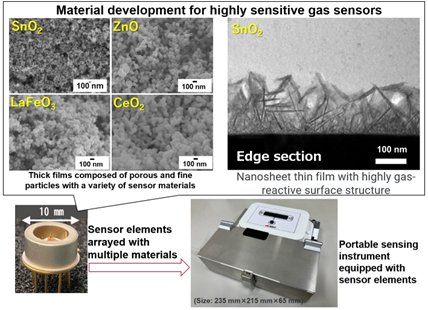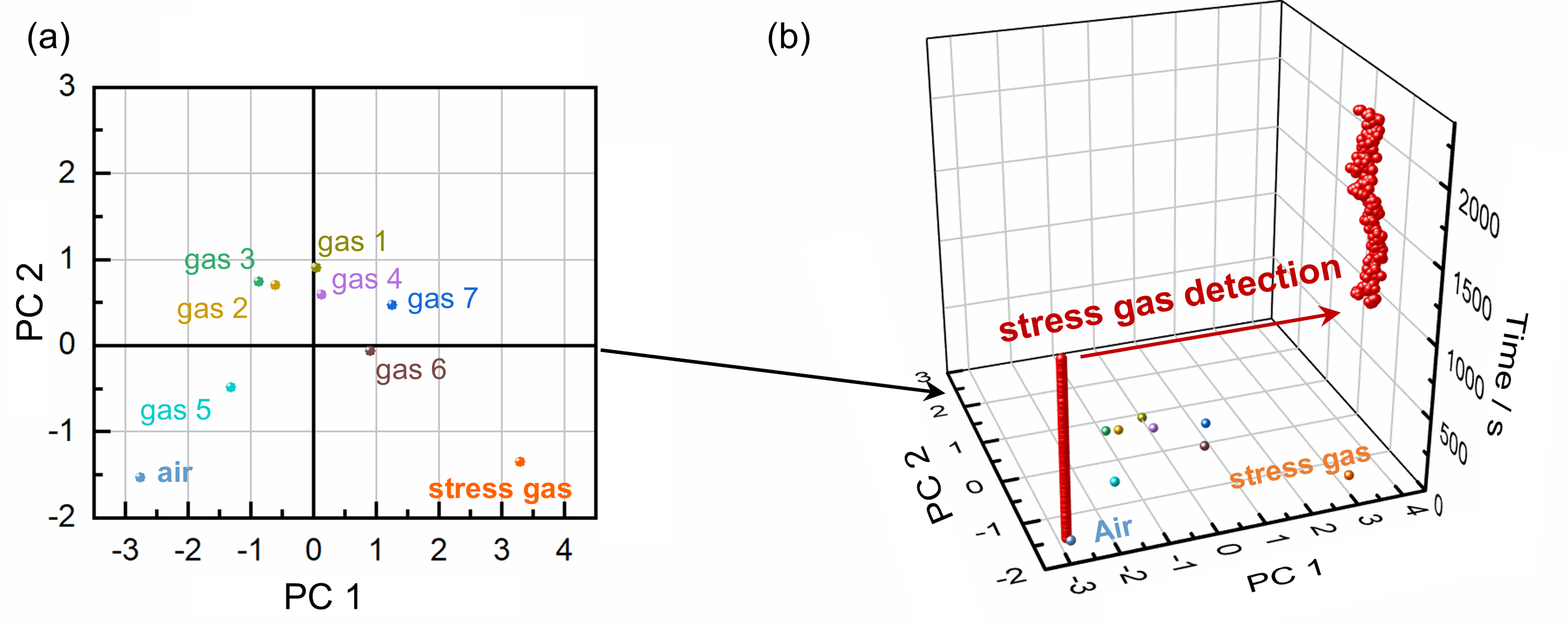Sensing Materials Research Group
We are developing sensing technologies that visualize invisible information and use this information to improve productivity and quality of life, as well as digital transformation technologies that utilize this information. We also take on the challenge for developing novel sensing materials that contribute to a circular economy society.
Group Research Theme
Sensor materials, sensor arrays, and portable sensing instruments
We are developing a variety of sensing materials for detecting odors with high sensitivity. Since sensing materials on semiconductor-type sensors should have a large specific surface area to interact with odor molecules, we have developed a manufacturing method that enables thick films composed of porous and fine particles with a variety of sensor materials. We applied this technology not only to conventional semiconductor-type sensor materials, but also to materials for “bulk-response sensors” developed by our group. Bulk-response sensors represented by cerium oxide are less affected by humidity existing in the atmosphere than conventional semiconductor-type sensors, and thus have succeeded in dramatically improving the accuracy of odor analysis (Reference 1). We also developed novel semiconductor-type sensors consisting of tin oxide nanosheets. This nanosheet-type sensors exhibit excellent gas response characteristics, which are clarified that these characteristics are due to the surface structure of the tin oxide nanosheet (Reference 2). We built portable sensing instruments equipped with sensor array including multiple types of sensors for measuring odors. Just as humans smell odors with their multiple receptors in nose and discriminate what kinds of odors in their brain, the instruments collect multiple sensor signals from installed sensor array and analyze kinds of odors using machine learning.
Reference 1:Odor monitoring in living space (Press Release 01/29/2019) [in Japanese]
Reference2:Sensor array for stress monitoring (Press Release 08/25/2022)[in Japanese]

Developed sensing materials, sensor arrays and portable sensing instruments
Initiatives aimed at social implementation of sensing technology
There is always a reason for the occurrence of odors, which can be regarded as a medium for information on the causes of smells. We are conducting research to visualize odors and use this information to implement technology to improve productivity and quality of life. When humans are under stress due to tension, allyl mercaptan, one of stress gases, is produced from the skin. Tin oxide nanosheet sensors show an excellent response characteristic with a detection limit of approximately 200 ppt to the stress gas, and a sensor array with four different types of nanosheet sensors prepared by different manufacturing methods can discriminate the stress gas from other biomarker gases (Reference 2). We also conducted research on early detection of freshness of fish meat by smell, and showed that a sensor array consisting of eight semiconductor sensors can discriminate four freshness conditions of cultured yellowtail: “immediately after arrival,” “suitable for raw consumption,” “suitable for cooking,” and “spoiling” (Reference 3).

(a) Results of principal component analysis of response values from sensor arrays to various biomarker gases, and (b) time variation of sensor array response values when the target gas changes from air to stress gas (red circle marker, measured at 5-second intervals).
Staff Members
| Position | name | |
|---|---|---|
| Group Leader | ITOH Toshio | |
| Chief Senior Researcher | MASUDA Yoshitake | |
| Senior Researcher | YASUI Kyuichi | |
| Senior Researcher | TOMITA Atsuko | |
| Senior Researcher | TAKADA Yoko | |
| Senior Researcher | CHOI Pil Gyu |
- Top page
- About Us
- Research Groups
- Materials Joining Research Group
- Lightweight Metallic Materials Research Group
- Ceramic Components and Processing Research Group
- Engineering Ceramic Research Group
- Wood-based Composites Research Group
- Next-Generation Electromaterials Research Group
- Advanced Metal Powder and Process Research Group
- Sensing Materials Research Group
- Carbon-Neutral Materials Research Group
- Functional Magnetic Materials Research Group
- Environmentally Adaptive Interface Materials Research Group
- Job Opportunities
- Access
- Contact